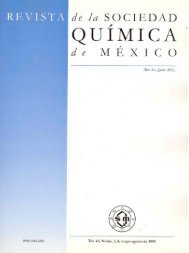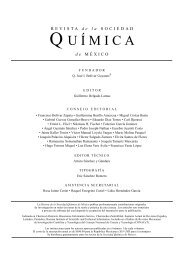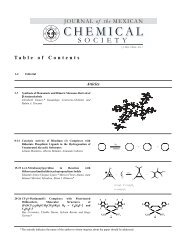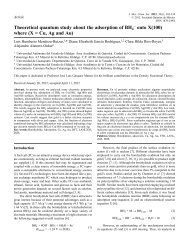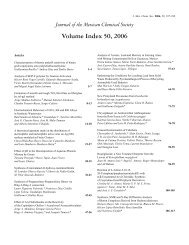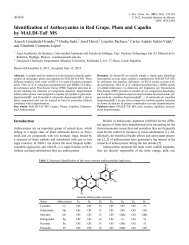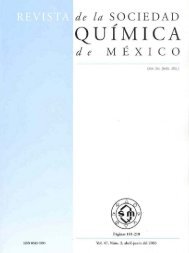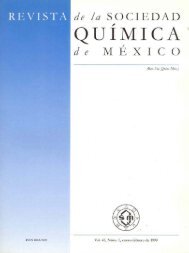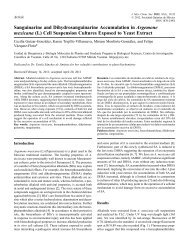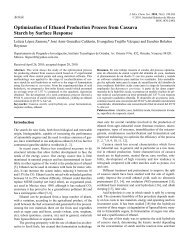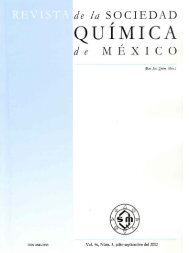Pincer Complexes. Applications in Catalysis
Pincer Complexes. Applications in Catalysis
Pincer Complexes. Applications in Catalysis
You also want an ePaper? Increase the reach of your titles
YUMPU automatically turns print PDFs into web optimized ePapers that Google loves.
Revisión<br />
<strong>P<strong>in</strong>cer</strong> <strong>Complexes</strong>. <strong>Applications</strong> <strong>in</strong> <strong>Catalysis</strong><br />
David Morales-Morales*<br />
Rev. Soc. Quím. Méx. 2004, 48, 338-346<br />
Instituto de Química, Universidad Nacional Autónoma de México, Ciudad Universitaria, Circuito Exterior,<br />
Coyoacán, 04510 México D. F. Tel. +52-55-56224514, Fax +52-55-56162217. E-mail: damor@servidor.unam.mx<br />
Recibido el 18 de octubre del 2004; aceptado el 7 de diciembre del 2004<br />
Dedicated to the memory of Dr. Raymundo Cruz Almanza<br />
Abstract. In the recent years the development of complexes hav<strong>in</strong>g<br />
<strong>in</strong> its structure p<strong>in</strong>cer type ligands has received considerable attention.<br />
Now a days these complexes are designed and synthesized not<br />
just for the mere structural <strong>in</strong>terest, but for the great number of potential<br />
applications that these compounds may have, <strong>in</strong>clud<strong>in</strong>g their use<br />
as robust catalysts, motifs <strong>in</strong> molecules that exhibit self assembly<br />
arrangements, synthons for their employment <strong>in</strong> Medic<strong>in</strong>al Chemistry<br />
and as fundamental components <strong>in</strong> the synthesis of dendrimeric materials<br />
for their potential use <strong>in</strong> catalysis. Thus, the present review<br />
shows the multiple applications that the p<strong>in</strong>cer complexes have had <strong>in</strong><br />
particular <strong>in</strong> the area of catalysis and the future perspectives of applications<br />
of these compounds <strong>in</strong> chemistry.<br />
Key words: PCP p<strong>in</strong>cer ligands, SCS p<strong>in</strong>cer ligands, NCN p<strong>in</strong>cer ligands,<br />
p<strong>in</strong>cer type complexes, catalysis.<br />
Introduction<br />
In 1976 Moulton and Shaw [1] synthesized for the first time a<br />
p<strong>in</strong>cer type ligand. In that po<strong>in</strong>t this ligand and its correspond<strong>in</strong>g<br />
complexes only represented some very novel derivatives<br />
of a new diphosph<strong>in</strong>e. These ligands and their complexes were<br />
forgotten for one decade. Then <strong>in</strong> the 80’s a careful reexam<strong>in</strong>ation<br />
of the properties of these complexes revealed this compounds<br />
to have an extraord<strong>in</strong>ary thermal stability, given their<br />
high melt<strong>in</strong>g po<strong>in</strong>ts (they sublime without decomposition),<br />
property that could enable these complexes to be potentially<br />
used <strong>in</strong> homogeneous catalysis. Now a days these species have<br />
been motif of multiple studies beyond catalysis, rang<strong>in</strong>g from<br />
application <strong>in</strong> nanoscience to the development of chemical<br />
sensors and chemical switches [2].<br />
The p<strong>in</strong>cer type complexes consist on a metallic center<br />
and of course a p<strong>in</strong>cer type ligand conta<strong>in</strong><strong>in</strong>g <strong>in</strong> its structure<br />
the donor atoms be<strong>in</strong>g thus capable of coord<strong>in</strong>ate <strong>in</strong> a tridentated<br />
manner to acquire the typical arrangement of the p<strong>in</strong>cer<br />
like ligands.<br />
Resumen. En los últimos años el desarrollo de la Química de compuestos<br />
conteniendo ligantes tipo p<strong>in</strong>cer (p<strong>in</strong>za para su traducción en<br />
español) ha tenido un gran avance, pasando de ser especies s<strong>in</strong>tetizadas<br />
meramente por su <strong>in</strong>terés estructural a formar parte hoy en día de<br />
uno de los motivos en Química mas utilizados por los químicos para<br />
el desarrollo de especies con diversas aplicaciones, que van desde su<br />
uso como precursores de catalizador, moléculas de <strong>in</strong>terés en procesos<br />
de autoensamblado, s<strong>in</strong>tones empleados en Química medic<strong>in</strong>al y<br />
el uso de estas moléculas como componentes fundamentales en la síntesis<br />
de materiales dendriméricos para usos múltiples entre los cuales<br />
resalta su profuso empleo en catálisis. De esta forma, la presente revisión<br />
representa una compilación de los múltiples y variados casos en<br />
los que compuestos tipo p<strong>in</strong>cer han sido empleados en procesos catalíticos<br />
así como las perspectivas de desarrollo de esta área.<br />
Palabras Clave: Ligandos tipo p<strong>in</strong>za PCP, Ligandos tipo p<strong>in</strong>za SCS,<br />
Ligandos tipo p<strong>in</strong>za NCN, complejos con ligantes tipo p<strong>in</strong>za, catálisis.<br />
It is believed that is the σ metal-carbon bond the responsible<br />
for the unique stability of these complexes, thus avoid<strong>in</strong>g<br />
the dissociation of the metal from the ligand and thus the<br />
decomposition of the complex, while the donor atoms and<br />
their correspond<strong>in</strong>g substituents allow the f<strong>in</strong>e tun<strong>in</strong>g of the<br />
steric and electronic properties. Moreover, modification of<br />
these substituents has allowed <strong>in</strong> the recent years to <strong>in</strong>corporate<br />
stereochemical centers capable of <strong>in</strong>duce chirality dur<strong>in</strong>g<br />
a given process. Thus, depend<strong>in</strong>g of the donor atoms <strong>in</strong> the<br />
p<strong>in</strong>cer ligands, these compounds are denom<strong>in</strong>ated as PCP p<strong>in</strong>cer<br />
complexes for those compounds hav<strong>in</strong>g phosphorus <strong>in</strong><br />
their structures, SCS for those conta<strong>in</strong><strong>in</strong>g sulfur, etc.<br />
The facility to modify and tune the properties of these ligands<br />
and their complexes has been reflected <strong>in</strong> the profuse<br />
employment of these species <strong>in</strong> different areas of chemistry,<br />
particularly <strong>in</strong> catalysis [3].<br />
Heck Reaction<br />
S<strong>in</strong>ce its discovery <strong>in</strong> the 60´s, the Heck reaction has turned<br />
<strong>in</strong>to a real power tool <strong>in</strong> organic synthesis, now a day reach<strong>in</strong>g<br />
the status of angular stone <strong>in</strong> the modern organic synthesis [4].<br />
In general the Heck reaction consists <strong>in</strong> the coupl<strong>in</strong>g of an αolef<strong>in</strong><br />
with a bromo or iodo derivative. Most of the processes<br />
<strong>in</strong>volv<strong>in</strong>g the Heck reaction are catalyzed by Pd(II) or Pd(0)<br />
derivatives <strong>in</strong> the presence of PPh 3 <strong>in</strong> excess.
<strong>P<strong>in</strong>cer</strong> <strong>Complexes</strong>. <strong>Applications</strong> <strong>in</strong> <strong>Catalysis</strong> 339<br />
Unfortunately, the reaction <strong>in</strong>termediates formed dur<strong>in</strong>g<br />
the catalytic reaction are sensitive to oxygen or thermally<br />
unstable, hamper<strong>in</strong>g the coupl<strong>in</strong>g process. In the recent years<br />
several research groups have done important advances with<br />
the aim of gett<strong>in</strong>g the ideal catalyst with the proper characteristics<br />
of reactivity and stability to carry out this process, the<br />
result of these experiments has lead to the researchers to the<br />
use of ortho metallated complexes, among which the p<strong>in</strong>cer<br />
type ligands represent one of the most important examples.<br />
Milste<strong>in</strong> and coworkers were the first to employ Pd(II)-PCP<br />
p<strong>in</strong>cer complexes (1, 2) <strong>in</strong> the Heck coupl<strong>in</strong>g reaction.<br />
Milste<strong>in</strong> found that these complexes were active without<br />
decomposition at reaction temperatures as high as 140 o C,<br />
over reaction periods of 300 hours or higher. By us<strong>in</strong>g these<br />
catalysts (1, 2) Milste<strong>in</strong> achieved full conversion <strong>in</strong> the coupl<strong>in</strong>gs<br />
of iodobenzene with methylacrylate, us<strong>in</strong>g Nmethylpyrrolid<strong>in</strong>e<br />
(NMP) as solvent and sodium carbonate as<br />
base with a maximum of 500,000 turnover numbers for<br />
iodobenzene and up to 132,900 for bromobencene.<br />
By the same time, Beller and Zapf [6] reported the use of<br />
electro-attractor phosphite ligands for the Heck coupl<strong>in</strong>gs of<br />
activated chlorobenzenes.<br />
Based on these results Jensen [7] et. al synthesized an<br />
analogous PCP p<strong>in</strong>cer type ligand based on phosph<strong>in</strong>ito fragments<br />
as P donors. The palladium derivatives of this ligand<br />
(3) where shown to be efficient <strong>in</strong> the coupl<strong>in</strong>g of chlorobenzenes,<br />
be<strong>in</strong>g one of the few examples then known to activate,<br />
deactivated or sterically h<strong>in</strong>dered chlorobenzenes.<br />
This complex (3) showed to be as reactive as the PCP<br />
phosph<strong>in</strong>o derivative reported previously by Milste<strong>in</strong>.<br />
A similar approach lead to Shibasaki [8] et. al, to the synthesis<br />
of complex (4), this compound was able to provide<br />
turnover numbers higher that 980,000.<br />
Several other p<strong>in</strong>cer type complexes and their palladium<br />
derivatives have been synthesized and used <strong>in</strong> the Heck reaction,<br />
<strong>in</strong>clud<strong>in</strong>g CNC ligands where C represents a carbon from<br />
a heterocyclic carbene [9] (5, 6) and SCS ligands (7) [10].
340 Rev. Soc. Quím. Méx. 2004, 48 David Morales-Morales<br />
These complexes have demonstrated analogous reactivities<br />
and stabilities as their phosph<strong>in</strong>ated counterparts.<br />
However, an <strong>in</strong>terest<strong>in</strong>g characteristic of the SCS p<strong>in</strong>cer ligands<br />
is the facile functionalization of the aromatic backbone<br />
to attach tails that <strong>in</strong> turn can be l<strong>in</strong>ked to polyethylene glycol<br />
supports (8), thus generat<strong>in</strong>g highly stable and highly active<br />
catalyst that can be easily separated, isolated and then used<br />
aga<strong>in</strong> for at least three cycles without decrease <strong>in</strong> activity [10].<br />
Thus, characteristics like the supreme activity and superior<br />
thermal stability that the palladium p<strong>in</strong>cer complexes have<br />
shown <strong>in</strong> the C-C coupl<strong>in</strong>g reactions (Heck type reactions),<br />
has lead to Jensen and Morales-Morales [7] to propose an<br />
alternative reaction mechanism <strong>in</strong>volv<strong>in</strong>g Pd(II)/Pd(IV) [5,7]<br />
species <strong>in</strong>stead of the traditionally accepted mechanism<br />
<strong>in</strong>volv<strong>in</strong>g Pd(0)/Pd(II) species. This reaction mechanism is<br />
still under debate.<br />
Suzuki-Miyaura Coupl<strong>in</strong>gs<br />
The Suzuki or Suzuki-Miyaura C-C coupl<strong>in</strong>gs [11] consist <strong>in</strong><br />
the reaction of a halobenzene with arylboronic acids <strong>in</strong> the<br />
presence of a base. This reaction proceeds by a similar reaction<br />
mechanism as that of the Heck reaction, thus most of the<br />
catalysts usually employed <strong>in</strong> the Heck coupl<strong>in</strong>g reactions<br />
have been successfully employed <strong>in</strong> the Suzuki reaction too.<br />
Thus, Pd(II) complexes hav<strong>in</strong>g phosph<strong>in</strong>ito PCP p<strong>in</strong>cer<br />
ligands (9) have been successfully used by Bedford et. al [12]<br />
<strong>in</strong> the coupl<strong>in</strong>gs of aryl halides with phenyl boronic acid,<br />
exhibit<strong>in</strong>g quantitative yields and turnover numbers <strong>in</strong> the<br />
order of 92,000. These complexes are also efficient <strong>in</strong> the coupl<strong>in</strong>gs<br />
of deactivated and sterically h<strong>in</strong>dered aryl bromides.<br />
On the other hand, Pd(II) SCS p<strong>in</strong>cer complexes (10)<br />
have also been employed <strong>in</strong> the Suzuki type coupl<strong>in</strong>gs, however<br />
their application has been limited be<strong>in</strong>g only active <strong>in</strong> the<br />
reaction of p-bromotoluene with phenyl boronic acid to a<br />
maximum of 69% yield of the correspond<strong>in</strong>g biphenyl [13].<br />
Dehydrogenation of alkanes<br />
Saturated hydrocarbons represent one of the most abundant<br />
and accessible feedstocks <strong>in</strong> our planet [14]. However, their<br />
use has been limited due to the <strong>in</strong>tr<strong>in</strong>sic lack of reactivity of<br />
these compounds [15]. An <strong>in</strong>terest<strong>in</strong>g alternative to this problem<br />
has been the use of transition metal complexes able to<br />
activate C-H bonds under mild reaction conditions [16]. Some
<strong>P<strong>in</strong>cer</strong> <strong>Complexes</strong>. <strong>Applications</strong> <strong>in</strong> <strong>Catalysis</strong> 341<br />
of these complexes have shown activity <strong>in</strong> the dehydrogenation<br />
of alkanes to alkenes. However, the extremely low reaction<br />
rates and the low turnover numbers or the <strong>in</strong>stability of<br />
the employed catalysts under the reaction conditions 16 has<br />
limited the use of these species.<br />
In 1976 Moulton and Shaw reported [1] for the first time<br />
the synthesis of the complex IrHCl{C 6H 3-2,6-(CH 2PBu t 2) 2}<br />
(11). They observed that this compound exhibited a high thermal<br />
stability, sublim<strong>in</strong>g without visible decomposition at temperatures<br />
as high as 180 o C. These results, led <strong>in</strong>dependently<br />
to the research groups of Jensen [16], Goldman [18] and<br />
Leitner [19] to the use of derivatives of this complex for its<br />
potential application as catalysts <strong>in</strong> the dehydrogenation of<br />
alkanes. Thus <strong>in</strong> 1998, Jensen and coworkers [20] reported the<br />
use of the dihydride rhodium complex RhH 2{C 6H 3-2,6-<br />
(CH 2PBu t 2) 2}(12) <strong>in</strong> the dehydrogenation of cyclooctane at<br />
150 o C, us<strong>in</strong>g tert-butylethylene as sacrificial hydrogen acceptor.<br />
This compound has been tested at reaction temperatures as<br />
high as 200 o C, show<strong>in</strong>g to be stable for periods of weeks.<br />
However the dehydrogenation reaction us<strong>in</strong>g this complex<br />
only afforded 1.8 turnovers at 200 o C. Further experiments,<br />
led Jensen and coworkers [21] to determ<strong>in</strong>e that it was <strong>in</strong> fact<br />
the iridium derivative IrH 2{C 6H 3-2,6-(CH 2PBu t 2) 2} (13) and<br />
not the rhodium complex (12) the best dehydrogenation catalyst.<br />
Thus, under the optimized conditions Jensen and coworkers<br />
were able to atta<strong>in</strong> turnover numbers of 720 at reaction<br />
temperatures of 200 o C, even though this complex exhibits<br />
excellent activity at temperatures as low as 150 o C (TON =<br />
82). Unfortunately, complex (13) is quickly deactivated by the<br />
formed product (product <strong>in</strong>hibition) [21].<br />
The complex IrH 2{C 6H 3-2,6-(CH 2PBu t 2) 2} (13), has been<br />
employed <strong>in</strong> the activation of C-H bonds of several substrates<br />
(vide supra) [21]; probably the most notable case be<strong>in</strong>g the<br />
dehydrogenation of l<strong>in</strong>ear alkanes to their correspond<strong>in</strong>g term<strong>in</strong>al<br />
alkenes (α-olef<strong>in</strong>s), be<strong>in</strong>g this the k<strong>in</strong>etically favored<br />
process. However, the same complex slowly catalyzes the isomerization<br />
of the term<strong>in</strong>al alkene to <strong>in</strong>ternal alkenes, be<strong>in</strong>g<br />
this the thermodynamic product [22].<br />
Further modifications <strong>in</strong> the PCP p<strong>in</strong>cer ligand, like<br />
chang<strong>in</strong>g substituents at the P moiety and different hydrogen<br />
acceptors has led to Goldman and coworkers [23] to <strong>in</strong>crease<br />
the efficiency of the catalytic system to a maximum of 68%<br />
selectivity for the term<strong>in</strong>al alkene <strong>in</strong> the catalytic dehydrogenation<br />
of n-octane with turnover numbers <strong>in</strong> the order of<br />
143. Further improvement to the system has been the elim<strong>in</strong>ation<br />
of the need of the sacrificial hydrogen acceptor, this<br />
achievement be<strong>in</strong>g the product of the jo<strong>in</strong> efforts of the Jensen<br />
and Goldman research groups, reach<strong>in</strong>g a 1000 turnovers<br />
under the optimized acceptorless conditions [24]. Further contribution<br />
by theoretical calculations [25] have led to the postulation<br />
of a tentative reaction mechanism through which complexes<br />
IrH 2{C 6H 3-2,6-(CH 2PBu t 2) 2} (13) and IrH 2{C 6H 3-2,6-<br />
(CH 2PPr i 2) 2} (14) carried out the alkane dehydrogenation both<br />
under hydrogen acceptor and acceptorless conditions [26].<br />
Recently, Kaska and coworkers [27] have reported a rigid<br />
PCP p<strong>in</strong>cer system based on antracene backbone (16), the iridium<br />
derivative of this ligand has demonstrated catalytic activity<br />
<strong>in</strong> the dehydrogenation of alkanes at temperatures as high<br />
as 250 o C without decomposition. Although even at this reac-
342 Rev. Soc. Quím. Méx. 2004, 48 David Morales-Morales<br />
tion temperature the system do not match the performance of<br />
the complexes 13 and 14, nor <strong>in</strong> yield of the term<strong>in</strong>al olef<strong>in</strong> or<br />
<strong>in</strong> the turnover numbers previously discussed.<br />
Hydrogen Transfer Reactions<br />
van Koten and coworkers have employed successfully ruthenium<br />
NCN (17) and PCP (18) p<strong>in</strong>cer complexes to perform<br />
hydrogen transfer reactions to reduce ketones to their correspond<strong>in</strong>g<br />
alcohols us<strong>in</strong>g iso-propanol as source of hydrogen<br />
and KOH as co-catalyst [28].<br />
Although both complexes are active catalysts <strong>in</strong> this<br />
process, the best yields and turnover numbers where obta<strong>in</strong>ed<br />
with the PCP p<strong>in</strong>cer derivatives, for <strong>in</strong>stance, for cyclohexanone,<br />
under reflux conditions, yields of 98% and turnover<br />
numbers of 27,000 were obta<strong>in</strong>ed, be<strong>in</strong>g these numbers the<br />
best so far obta<strong>in</strong>ed, compared with mono phosph<strong>in</strong>e ruthenium<br />
complexes like [RuCl 2(PPh 3)] or [RuCl(H)(PPh 3)] [29].<br />
Given these results, several attempts have been done with the<br />
aim of <strong>in</strong>terpolate this process to obta<strong>in</strong> enantiomerically pure<br />
alcohols, among these the use of chiral ruthenium PCP p<strong>in</strong>cer<br />
complexes (19) [30]. However, despite of the fact that com-<br />
plex 19 exhibits catalytic activity comparable to the non-chiral<br />
counterparts, the reaction of iso-PrOH and acetophenone only<br />
affords 14% ee [31].<br />
Aldolic Condensations<br />
The synthesis of enantiomerically pure oxazol<strong>in</strong>es can be conveniently<br />
done through the gold catalyzed [32] aldolic condensation<br />
reactions between an aldehyde or a ketone with an isocyanate.<br />
These compounds are very important, s<strong>in</strong>ce the consecutive<br />
hydrolysis of the oxazol<strong>in</strong>es obta<strong>in</strong>ed by this procedure,<br />
offers a simple and efficient route for the synthesis of βhydroxyam<strong>in</strong>oacids.<br />
It is noteworthy that the first enantiomerically pure PCP<br />
p<strong>in</strong>cer complexes were evaluated <strong>in</strong> this process. Venanzi and<br />
coworkers [33] designed these compounds by <strong>in</strong>troduc<strong>in</strong>g chiral<br />
acetals <strong>in</strong> the benzylic positions of the PCP ligands, the<br />
reaction be<strong>in</strong>g achieved by the Sharpless type enantioselective<br />
epoxydation.<br />
The plat<strong>in</strong>um derivative of this ligand (20) has shown to<br />
be active <strong>in</strong> the asymmetric aldolic addition of methyl-α-isocyanoacetate<br />
with aldehydes to yield moderated enantiomeric<br />
yields of 32% and 65% ee for the correspond<strong>in</strong>g cis and trans<br />
oxazol<strong>in</strong>es respectively. This reaction is carried out <strong>in</strong> the<br />
presence of a base that acts as cocatalyst for the formation of<br />
the metal-isocyanoenolate <strong>in</strong>termediate (21).
<strong>P<strong>in</strong>cer</strong> <strong>Complexes</strong>. <strong>Applications</strong> <strong>in</strong> <strong>Catalysis</strong> 343<br />
However, the synthesis of these compounds is difficult<br />
and tedious, thus its potential application has been limited.<br />
Recently, Zhang and coworkers [34] have reported an easier<br />
and efficient route for the synthesis of enantiomerically pure<br />
PCP p<strong>in</strong>cer ligands and their Pd(II) complexes (22).<br />
The use of the palladium derivatives of this ligand (22) <strong>in</strong><br />
the same reaction reported by Venanzi, affords the formation<br />
of oxazol<strong>in</strong>es <strong>in</strong> high yields, with high enantioselectivity for<br />
the formation of the cis-oxazol<strong>in</strong>es. This example once more<br />
illustrates the importance of the proper selection of the ligand<br />
and metal for a particular transformation.<br />
Other chiral p<strong>in</strong>cer type complexes have also been<br />
employed. For <strong>in</strong>stance, ligands <strong>in</strong>clud<strong>in</strong>g ozaxol<strong>in</strong>es <strong>in</strong> their<br />
backbones afford modest results <strong>in</strong> the synthesis of oxazol<strong>in</strong>es<br />
[35].<br />
In addition, SCS p<strong>in</strong>cer ligands <strong>in</strong>clud<strong>in</strong>g chiral groups<br />
have also been employed <strong>in</strong> this reaction. Unfortunately, the<br />
chiral <strong>in</strong>duction us<strong>in</strong>g this k<strong>in</strong>d of complexes resulted to be<br />
zero, this be<strong>in</strong>g probably due to the fact that the chiral centers<br />
are located too far from the metal center to have a significant<br />
effect <strong>in</strong> the chiral discrim<strong>in</strong>ation dur<strong>in</strong>g the reaction [36].<br />
Most recently Morales-Morales and coworkers [37] have<br />
synthesized a PCP p<strong>in</strong>cer ligand (25) and its palladium derivatives<br />
(26) hav<strong>in</strong>g the chiral centers at the phosphorus atoms<br />
and used them <strong>in</strong> the same reaction with poor enantiomeric<br />
excesses <strong>in</strong> the order of 6%. In this case it does seems that the<br />
R groups at the P* chiral centers are too similar <strong>in</strong> size to led<br />
to a good chiral discrim<strong>in</strong>ation, thus efforts po<strong>in</strong>t<strong>in</strong>g to the<br />
design of similar ligands with bulkier requirements are under<br />
way.<br />
Asymmetric allylic alkylation<br />
In the recent years, the allylic alkylation reaction <strong>in</strong> its asymmetric<br />
fashion has received considerable <strong>in</strong>terest; proof of this<br />
is the tremendous number (more than a 1000) of chiral<br />
diphosph<strong>in</strong>es that have been synthesized for this particular<br />
reaction. In the field of the p<strong>in</strong>cer ligands Zhang and coworkers<br />
[38] have used the PCP p<strong>in</strong>cer chiral ligand 22, previously<br />
employed <strong>in</strong> the aldolic condensation reaction, <strong>in</strong> the reaction<br />
of dimethyl malonate with 1,3-diphenyl-2-propenyl acetate<br />
us<strong>in</strong>g [Pd(C 3H 5)Cl 2] 2 as a source of palladium, atta<strong>in</strong><strong>in</strong>g<br />
yields <strong>in</strong> the order of 50 to 94%. This particular reaction proceeds<br />
at room temperature; however decreas<strong>in</strong>g of the reaction<br />
temperature <strong>in</strong>creases considerably the enantiomeric yields to<br />
a maximum of 79% ee for the enantiomer (R).
344 Rev. Soc. Quím. Méx. 2004, 48 David Morales-Morales<br />
Recent advances<br />
As it can be noted from the above, the p<strong>in</strong>cer ligands an their<br />
metallic derivatives represent <strong>in</strong> many cases the ideal examples<br />
to carry out catalytic processes otherwise difficult or<br />
impossible to be carried out with conventional diphosph<strong>in</strong>e<br />
ligands. The versatility of these species to be modified and<br />
modulated both steric and electronically, makes these compounds<br />
an their correspond<strong>in</strong>g transition metal derivatives<br />
attractive complexes to be cont<strong>in</strong>uously used <strong>in</strong> different challeng<strong>in</strong>g<br />
catalytic processes. Thus, around the world several<br />
important research groups ma<strong>in</strong>ta<strong>in</strong> as priority research l<strong>in</strong>es<br />
the design of new p<strong>in</strong>cer ligands, their complexes and their<br />
potential applications, while other research groups have foreseen<br />
the potential of these complexes by use them as catalyst<br />
<strong>in</strong> different organic transformations. It is noteworthy the use<br />
of the palladium–phosph<strong>in</strong>ito PCP p<strong>in</strong>cer complex 27 [39] <strong>in</strong><br />
the synthesis of corannulenes <strong>in</strong> high yields recently reported<br />
by Siegel and coworkers [40].<br />
Moreover, Zsabó and coworkers [41] have found the palladium<br />
derivatives of NCN and PCP p<strong>in</strong>cer complexes to be<br />
active catalysts <strong>in</strong> the allylic stannylation reaction with high<br />
yields.<br />
Recently, Morales-Morales and coworkers have extended<br />
the application of the iridium p<strong>in</strong>cer complexes IrH 2{C 6H 3-<br />
2,6-(CH 2PR 2) 2} (R= Bu t , Pr i ) for their application <strong>in</strong> the catalytic<br />
dehydrogenation of am<strong>in</strong>e [42] and alcohols [43], provid<strong>in</strong>g<br />
alternative high yield methods for the synthesis of<br />
im<strong>in</strong>es and ketones and aldehydes.<br />
Additionally, Goldman et. al [44] has recently reported<br />
the use of these same species for the catalytic dehydrogenation<br />
of tertiary am<strong>in</strong>es to enam<strong>in</strong>es <strong>in</strong> good yields.<br />
Furthermore, Brookhart et al. [45] and Morales-Morales<br />
et al [46] have recently reported, <strong>in</strong>dependently, the use of<br />
Iridium-Phosph<strong>in</strong>ito PCP p<strong>in</strong>cer type complexes <strong>in</strong> the catalytic<br />
dehydrogenation of alkanes, thus match<strong>in</strong>g the yields and<br />
performance of the previously reported phosph<strong>in</strong>o analogues.<br />
However, these complexes exhibit additional advantages compared<br />
to their phosph<strong>in</strong>o counterparts, such as the fact that the<br />
phosph<strong>in</strong>ito PCP p<strong>in</strong>cer ligands can be obta<strong>in</strong>ed <strong>in</strong> an easier<br />
manner and <strong>in</strong> higher yields; and, second, that the hydrido<br />
species are not necessary, s<strong>in</strong>ce this complex can be formed <strong>in</strong><br />
situ by pla<strong>in</strong> addition of a strong base, like NaOBu t .<br />
The cont<strong>in</strong>uous search for more specific ligands [47], has<br />
taken several research groups to the synthesis of more complex<br />
ligands as well as their transition metal complexes, with<br />
more elaborated structures <strong>in</strong>clud<strong>in</strong>g fullerene (28) [48] or ferrocene<br />
(29) [49] backbones or very sterically h<strong>in</strong>dered ligands<br />
(30) that have allowed to block, <strong>in</strong> a very specific way, partic-
<strong>P<strong>in</strong>cer</strong> <strong>Complexes</strong>. <strong>Applications</strong> <strong>in</strong> <strong>Catalysis</strong> 345<br />
ular quadrants <strong>in</strong> the complex and thus make them able to provide<br />
exceed<strong>in</strong>gly good enantiomeric excess values <strong>in</strong>, for<br />
<strong>in</strong>stance, asymmetric Michael additions [50].<br />
It results easy to forecast that the chemistry of p<strong>in</strong>cer ligands<br />
would cont<strong>in</strong>ue to grow and evolve <strong>in</strong> the follow<strong>in</strong>g<br />
years, to be <strong>in</strong>cluded <strong>in</strong> new and emerg<strong>in</strong>g areas of chemistry.<br />
Now a days silver(I) systems hav<strong>in</strong>g the p<strong>in</strong>cer motif <strong>in</strong> their<br />
structure have been considered for their application <strong>in</strong><br />
Medic<strong>in</strong>al Chemistry as antimicrobial agents (31) [51],<br />
bioorganometallic chemistry (32) [52], and more recently used<br />
<strong>in</strong> the design of nanostructured and dendrimeric systems for<br />
their application <strong>in</strong> catalytic heterogeneized systems and<br />
supramolecular chemistry (33) [53].<br />
References<br />
1. Moulton, C. J.; Shaw, B. L. J. Chem. Soc., Dalton Trans. 1976,<br />
1020–1024.<br />
2. van Koten, G.; Albrecht, M. Angew. Chem. Int. Ed. 2001, 40,<br />
3750–3781.<br />
3. van der Boom, M. E.; Mislte<strong>in</strong>, D. Chem. Rev. 2003, 103, 1759-<br />
1792.
346 Rev. Soc. Quím. Méx. 2004, 48 David Morales-Morales<br />
4. Heck, R. F. J. Am. Chem. Soc. 1968, 90, 5518–5526. b) Heck, R.<br />
F. Org. React. 1982, 27, 345–390. c) Heck, R. F. Comprehensive<br />
Organic Synthesis: Selectivity, Strategy and Efficiency <strong>in</strong> Modern<br />
Organic Chemistry; Trost, B. M.; Flem<strong>in</strong>g, I., Eds.; 1991; Vol. 4.<br />
p 833, Chapter 4.3. d) Cabri, W. Acc. Chem. Res. 1995, 28, 2–27.<br />
e) Beletskaya, I. P.; Cheprakov, A.V. Chem. Rev. 2000, 100,<br />
3009-3066.<br />
5. Ohff, M.; Ohff, A.; van der Boom, M. E.; Milste<strong>in</strong>, D. J. Am.<br />
Chem. Soc. 1997, 119, 11687–11688.<br />
6. Beller, M.; Zapf, A. Synlett 1998, 792–794.<br />
7. Morales-Morales, D.; Redón, R.; Yung, C.; Jensen, C. M. Chem.<br />
Commun. 2000, 1619–1620. b) Morales-Morales, D.; Grause, C.;<br />
Kasaoka, K.; Redón, R.Cramer, R. E.; Jensen, C. M. Inorg. Chim.<br />
Acta 2000, 300-302, 958–963.<br />
8. Miyazaki, F.; Yamaguchi, K.; Shibasaki, M. Tetrahedron Lett.<br />
1999, 40, 7379–7383.<br />
9. Peris, E.; Loch, J. A.; Mata, J.; Crabtree, R. H. Chem. Commun.<br />
2001, 201–202. b) Grundemann, S.; Albrecht, M.; Loch, J. A.;<br />
Faller, J. W.; Crabtree, R. H. Organometallics 2001, 20,<br />
5485–5488. c) Tulloch, A. A. D.; Danopoulos, A. A.; Tizzard, G.<br />
J.; Coles, S. J.; Hursthouse, M. B.; Hay-Motherwell, R. S.;<br />
Motherwell, W. B. Chem. Commun. 2001, 1270–1271.<br />
10.Arroyo, M.; Cervantes, R.; Gómez-Benítez, V.; López, P.;<br />
Toscano, R.A.; Morales-Morales, D.; Torrens, H. Synthesis-<br />
Stuttgart. 2003, 1565-1568. b) Bergbreiter, D. E.; Osburn, P. L.;<br />
Liu, Y.-S. J. Am. Chem. Soc. 1999, 121, 9531–9538.<br />
11. Suzuki, A. J. Organomet. Chem. 1999, 576, 147–168. b) Suzuki,<br />
A. Chem. Rev. 1995, 95, 2457–2483.<br />
12. Bedford, R. B.; Draper, S. M.; Scully, P. N.; Welch, S. L. New J.<br />
Chem. 2000, 24, 745–747.<br />
13. Zim, D.; Gruber, A. S.; Ebel<strong>in</strong>g, G.; Dupont, J.; Monteiro, A. L.<br />
Org. Lett. 2000, 2, 2881–2884.<br />
14. Jones, D. W. Science 2000, 287, 1942.<br />
15. Kakiuchi, F. and Murai, S. In Activation of Unreactive Bonds and<br />
Organic Synthesis, S. Murai, Ed. Spr<strong>in</strong>ger-Verlag, Berl<strong>in</strong>, 1999,<br />
chap. 3, pp. 56-58.<br />
16. Crabtree, R. H.; Mihelcic, J. M.; Quirk, J. M. J. Am. Chem. Soc.<br />
1979, 101, 7738; b) Baudry, D.; Ephritikh<strong>in</strong>e, M.; Felk<strong>in</strong>, H.;<br />
Holmes-Smith, R. J. Chem. Soc. Chem. Commun. 1983, 788; c)<br />
Felk<strong>in</strong>, H.; Fillebeen-Khan, T.; Holmes-Smith, R.; Zakrzewski, J.<br />
Tetrahedron Lett. 1964, 25, 1279; d) Felk<strong>in</strong>, H.; Fillebeen-Khan,<br />
T.; Holmes-Smith, R. L<strong>in</strong>, Y. Tetrahedron Lett. 1985, 26, 1999;<br />
e) Burk, M. W.; Crabtree, R. H.; McGrath, D. V. J. Chem Soc.<br />
Chem. Commun. 1985, 1829; f) Burk, M. W.; Crabtree, R. H. J.<br />
Am. Chem. Soc. 1987, 109, 8025.<br />
17. Gupta, M.; Hagen, C.; Flesher, R. J.; Kaska, W. C.; Jensen, C. M.<br />
Chem. Commun. 1996, 2083–2084.<br />
18. Wang, K.; Goldman, M. E.; Emge, T. J.; Goldman, A. S. J.<br />
Organomet. Chem. 1996, 518, 55–68.<br />
19. Leitner, W.; Six, C. Chem. Ber./Recueil. 1997, 130, 555–558.<br />
20. Lee, D. W.; Kaska, W. C.; Jensen, C. M. Organometallics 1998,<br />
17, 1–3.<br />
21. Gupta, M.; Hagen, C.; Kaska, W. C.; Crammer, R. E.; Jensen, C.<br />
M. J. Am. Chem. Soc. 1997, 119, 840–841. b)Gupta, M.; Kaska,<br />
W. C.; Jensen, C. M. Chem. Commun. 1997, 461–462. c) Gómez-<br />
Benítez, V.; Redón, R.; Morales-Morales, D. Rev. Soc. Quim.<br />
Mex. 2003 (47) 124-126.<br />
22. Liu, F.; Pak, E. B.; S<strong>in</strong>gh, B.; Jensen, C. M.; Goldman, A. S. J.<br />
Am. Chem. Soc. 1999, 121, 4086–4087.<br />
23. Liu, F.; Goldman, A. S. Chem. Commun. 1999, 655–656.<br />
24 Xu, W.; Ros<strong>in</strong>i, G. P.; Gupta, M.; Jensen, C. M.; Kaska, W.<br />
C.;Krogh-Jespersen, K.; Goldman, A. S. Chem. Commun. 1997,<br />
2273–2274.<br />
25. Li, S.; Hall, M. B. Organometallics 1999, 18, 5682. b) Niu, S.;<br />
Hall, M. B. J. Am. Chem. Soc. 1999, 121, 3992. c) Krogh-<br />
Jespersen, K.; Czerw, M.; Kanzelberger, M.; Goldman, A. S. J.<br />
Chem. Inf. Comput. Sci. 2001, 41, 56. d) Krogh-Jespersen, D.;<br />
Czerw, M.; Summa, N.; Renkema, K. B.; Achord, P. A.;<br />
Goldman, A. S. J. Am. Chem. Soc. 2002, 124, 11404-11416. e)<br />
Krogh-Jespersen, K.; Czerw, M.; Goldman, A. S. J. Mol. Catal.<br />
A.: Chem. 2002, 189, 95.<br />
26. Jensen, C. M. Chem. Commun. 1999, 2443–2449.<br />
27. Haenel, M. W.; Oevers, S.; Angermund, K.; Kaska, W. C.; Fan,<br />
H.-J.; Hall, M. B. Angew. Chem., Int. Ed. 2001, 40, 3596.<br />
28. Dani, P.; Karlen, T.; Gossage, R. A.; Gladiali, S.; van Koten, G.<br />
Angew. Chem. Int. Ed. 2000, 39, 743–745.<br />
29. Naota, T.; Takaya, H.; Murahashi, S.-I. Chem. Rev. 1998, 98,<br />
2599.<br />
30. Dani, P.; Albrecht, M.; van Kl<strong>in</strong>k, G. P. M.; van Koten, G.<br />
Organometallics 2000, 19, 4468.<br />
31.Albrecht, M.; Kocks, B. M.; Spek, A. L.; van Koten, G. J.<br />
Organomet. Chem. 2001, 624, 271.<br />
32. Ito, Y.; Sawamura, M.; Hayashi, T. J. Am. Chem. Soc. 1986, 108,<br />
6405–6406.<br />
33. Gorla, F.; Togni, A.; Venanzi, L. M.; Alb<strong>in</strong>ati, A.; Lianza, F.<br />
Organometallics 1994, 13, 1607. b) Gorla, F.; Venanzi, L. M.;<br />
Alb<strong>in</strong>ati, A. Organometallics 1994, 13, 43.<br />
34. Zhang, X.; Longmire, J. M.; Shang, M. Organometallics 1998,<br />
17, 4374–4379.<br />
35.Stark, M. A.; Richards, C. J. Organometallics 2000, 19,<br />
1282–1291.<br />
36 Gimenez, R.; Swager, T. J. Mol. Catal. A: Chem. 2001, 166,<br />
265–273.<br />
37 Morales-Morales, D.; Cramer, R. E.; Jensen, C. J. Organomet.<br />
Chem. 2002, 654, 44.<br />
38.Longmire, J. M.; Zhang, X. Tetrahedron Lett. 1997, 38,<br />
1725–1728.<br />
39 Morales-Morales, D.; Grause, C.; Kasaoka, K.; Redón, R.Cramer,<br />
R. E.; Jensen, C. M. Inorg. Chim. Acta 2000, 300-302, 958–963.<br />
40 Grube, G. H.; Elliott, E. L.; Steffens, R. J.; Jones, C. S.;<br />
Baldridge, K. K.; Siegel, J. S. Org, Lett. 2003, 5, 713-716.<br />
41 Wallner, O. A.; Szabó, K. J. Org. Lett. 2004, 6, 1829-1831.<br />
42 Gu, X-Q.; Chen, W.; Morales-Morales, D.; Jensen, C. J. Mol.<br />
Catal A. 2002, 189, 119-124.<br />
43 Morales-Morales, D.; Redón, R.; Wang, Z.; Yung, C.; Magnuson,<br />
K.; Jensen, C. M. Can. J. Chem. 2001, 79, 823-829.<br />
44. Zhang, X. W.; Fried, A.; Knapp, S.; Goldman, A. S. Chem.<br />
Commun. 2003, 2060-2061.<br />
45. Gottker-Schnetmann, I.; White, P.; Brookhart, M. J. Am. Chem.<br />
Soc. 2004, 126, 1804-1811.<br />
46 Morales-Morales, D; Redón, R; Yung, C; Jensen, C. M. Inor.<br />
Chim. Acta. 2004, 357, 2953-2956.<br />
47.Naghipour, A.; Sabounchei, S. J.; Morales-Morales, D.;<br />
Hernández-Ortega, S.; Jensen, C. M. J. Organomet. Chem. 2004,<br />
689, 2494-2502.<br />
48. Meijer, M. D.; Mulder, B.; Van Kl<strong>in</strong>k, P. M. G.; van Koten, G.<br />
Inorg. Chim. Acta. 2003, 352, 247-252.<br />
49. Koridze, A. A.; Kukl<strong>in</strong>, S. A.; Sheloumov, A. M.; Kondrashov,<br />
M. V.; Dolgush<strong>in</strong>, F. M.; Peregudov, A. S.; Petrovskiia, P. V.<br />
Russ. Chem. Bull., Int. Ed., 2003, 52, 2754-2756.<br />
50. Takenaka, K.; Uozumi, Y. Org. Lett. 2004, ASAP.<br />
51.Melaiye, A.; Simons, R, S.; Milsted, A.; P<strong>in</strong>gitore, F.;<br />
Wesdemiotis, C.; Tessier, C. A.; Youngs, W. J. J. Med. Chem.<br />
2004, 47, 973-977.<br />
52. Guillena, G.; Rodríguez, G.; van Koten, G. Tetrahedron Lett.<br />
2002, 43, 3895–3898.<br />
53.Kleij, A. W.; Gossage, R. A.; Kle<strong>in</strong> Gebb<strong>in</strong>k, R. J. M.;<br />
Br<strong>in</strong>kmann, N.; Reijerse, E. J.; Kragl, U.; Lutz, M.; Spek, A. L.;<br />
van Koten, G. J. Am. Chem. Soc. 2000, 122, 12112. b) Knapen, J.<br />
W. J.; van der Made, A. W.; de Wilde, J. C.; van Leeuwen, P.W.<br />
N.M.; Wijkens, P.; Grove, D. M.; van Koten, G. Nature 1994,<br />
372, 659. c) Kleij, A. W.; Gossage, R. A.; Jastrzebski, J. T. B. H.;<br />
Lutz, M.; Spek, A. L.; van Koten, G. Angew. Chem. Int. Ed. 2000,<br />
39, 176.




